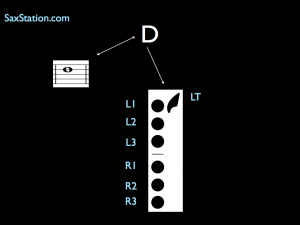Certain notes on saxophone, cough cough middle D,
seem to come out stuffy on almost all saxophones.
Why is that?
The sound that you create when playing saxophone isn’t just coming out of the bell of the saxophone, except when you’re playing low Bb.
The sound goes through every open tone hole on the saxophone. So for a note like C# (in the middle of the staff) not very much sound actually goes through the bell at all. All the open tone holes are options.
With more fingers down, the sound is more closed.
So middle D is more much more closed than C# and they’re only a half step apart.
Eb, E, F all have a good number of tone holes closed and are a bit more stuffy than their open holed counterparts.
But middle D does seem to be the worst culprit.
Some sax players will suggest adding the palm D key when you’re playing middle D to open it up.
This action does open the sound a bit….. it’s practical part of the time. But not necessarily something you should always rely on.
As you play saxophone longer and learn the nuances of your horn, you should realize the differences between open and closed notes and adjust accordingly. Give middle D a bit more air, back off of notes like B and A that are more open by a little bit.
The distance that the low Bb and B pads are open can also be adjusted to help stuffy notes. Be very careful with this though, don’t want to mess up your saxophone!
Any thoughts on the issue of stuffy saxophone notes?




Good Points, Neal. Additionally, the low D is usually low in pitch and stuffy due to the low C# key being the only closed key before the end of the bell. If you open the low C# while fingering low D the note is much easier to play and much better in tune. It is great if you have to start softly on the low D.
Thanks,
John
Hey John,
Read what you wrote, that’s a good point about the setup of the saxophone and why D is stuffy. However, low D tends to be pretty well in tune for me. When I pressed the low C# key along with it, it went 20 cents sharp. So that will bring it up in pitch. If it is flat, that could probably work…. but it might take it too far it seems.
-Neal
Hi Neal,
True, if the low D is in tune the C# key does raise the pitch too far. I have played some saxes where the low D is flat so this works well in those cases. What I like best about using the C# is that it allows me to start the tone with less resistance. Further, I can adjust the embouchure to play the note in tune. Easier to lower it than to try to raise it with just the embouchure.
John
Hey John,
Very true, it is much easier to bring the pitch down than it is to raise it. So it sounds like that trick helps with certain saxophones probably in combination with ‘lipping it down’, ideally you don’t want to rely on it unless you have to though I would say.
-Neal